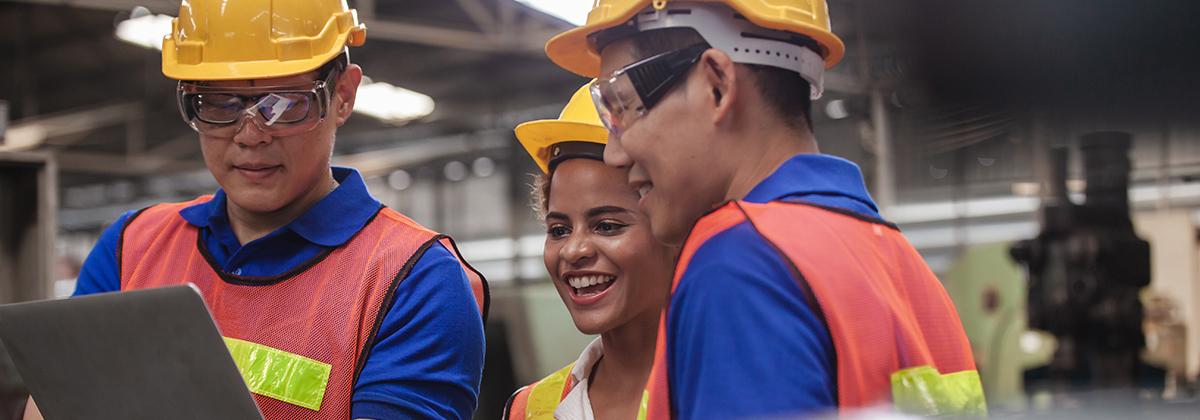Companies with high-performing maintenance engineering teams outperform their competitors on all key business metrics, according to research by McKinsey. Here’s how you can build a winning engineering team.
Reliability – it’s the goal of every maintenance engineering team. Some would say it’s all down to technology, but according to research by McKinsey, it’s the people who make the difference.
As a global consulting firm, McKinsey works with manufacturers of all types. Using data from their clients, they identified a group of organisations who outperform competitors on all key business metrics while achieving low levels of downtime and few breakdowns.
For their report “What high-reliability organisations get right”, McKinsey studied maintenance engineering teams in sectors ranging from mining, energy, power generation and distribution to pharmaceuticals, airlines and military.
Unsurprisingly, they all made use of Industry 4.0 technologies like condition monitoring and data analytics. But what made them really successful was not technology, but the people in their maintenance engineering teams.
“Technology alone does not make for excellence in reliability,” says McKinsey. “In industries that live by the laws of science, leaders often underestimate the role of management processes and skills in reliability engineering.”
The key factors, according to their analysis, are: rigorous processes; role clarity; and accountability systems. The successful organisations place a premium on skills and invest in professional development for their maintenance engineers.
Build a strong maintenance engineering team
Ian Bell, Vice President of Engineering and Facilities at RS Group, agrees about the need to develop the team: “Attract and retain great people. Make sure you grow your own at the same time. Make sure you engage them and create that bit of passion and enthusiasm.”
“So you need great people, but great processes, too – you've got to understand what you do. How you deploy your staff, how you manage your priorities and tasks, and having them clearly defined is really important, too.”
All the successful organisations in the McKinsey study had clear lines of accountability for maintenance from the top down, robust maintenance processes and clearly defined roles and responsibilities for everyone in the team.
Richard Jeffers, Managing Director RS Industria at RS Group, agrees that clarity of purpose is essential: “Everyone in the maintenance engineering team needs to understand what they are there to do,” he says.
“So, communication is absolutely critical. It’s not surprising if operational colleagues get frustrated if we’re unclear about what we’re here for,” he adds. “The purpose of a maintenance organisation is keeping operational assets in the hands of the user at least cost.”
As well as closely monitoring asset performance, McKinsey found that high performance teams also used data and their subject-matter expertise to establish the root cause of every failure to ensure it will not happen again.
Support knowledge sharing
Knowledge sharing was a key aspect of their success, with robust systems to preserve, share and apply their collective knowledge by, for example, updating work processes after every breakdown to make sure it was not repeated.
“Robust maintenance process is about people – the great team that are highly engaged with processes that are known and defined and intuitive,” says RS’s Ian Bell. “You need to be smart, but it does need money. You can’t do it on a shoestring – if the company wants excellence or world class, they have to pay for it,” he adds.
McKinsey says one of the key elements needed to build a great maintenance engineering team is good pay: “Salaries at the high-reliability organisations – average, as well as the low and high end of pay scales – were 15% higher than those of their peers.” Some also had performance-based pay and bonuses based on uptime.
Career progression is also essential to keep maintenance engineers motivated, McKinsey found. The most successful companies had promotion routes leading to roles as company-wide subject-matter experts, advising colleagues across all divisions.
Maintenance Engineering Academic Dr Moray Kidd says that maintenance engineers need senior role models who demonstrate how they can progress. But he thinks the UK may be lacking when it comes to putting engineers into top jobs.
He contrasts that with his experience working for a major German company where “it's quite normal for engineers to be managing directors and decision-makers within organisations”. The UK needs to catch up, he says.
Good maintenance engineering pays for itself
Whatever the career challenges, RS’s Richard Jeffers says the fundamentals of effective maintenance engineering have not changed. “The idea of looking at the outputs of your actions and then using that to drive future actions and do it better next time, is not new,” he says.
“We’re not suddenly much cleverer in the 21st century than they were in the previous one. I think what’s fundamentally changed in maintenance is a recognition that data can drive your maintenance strategy.
“And if you understand failure modes, failure theory, and the leading indicators of failure, then you can start to use that understanding to drive your maintenance strategy in a structured fashion.
“At the same time, you’ve still got to get people to respond to the data and to value the engineer who stays calm because they’re in control, more than the hero who runs and fixes that machine at two o’clock in the morning. Sadly, many businesses are still rewarding the hero culture, rather than the analytical one.”
Dr Moray Kidd is optimistic that things will change as business leaders realise that effective maintenance engineering delivers business success. “Maintenance engineering has historically been seen as a sort of an overhead,” he says.
“But I think going forward, people will come to appreciate that good maintenance engineering does not cost you: it should pay you. And so, if it’s done well, it’s a sound investment.”





